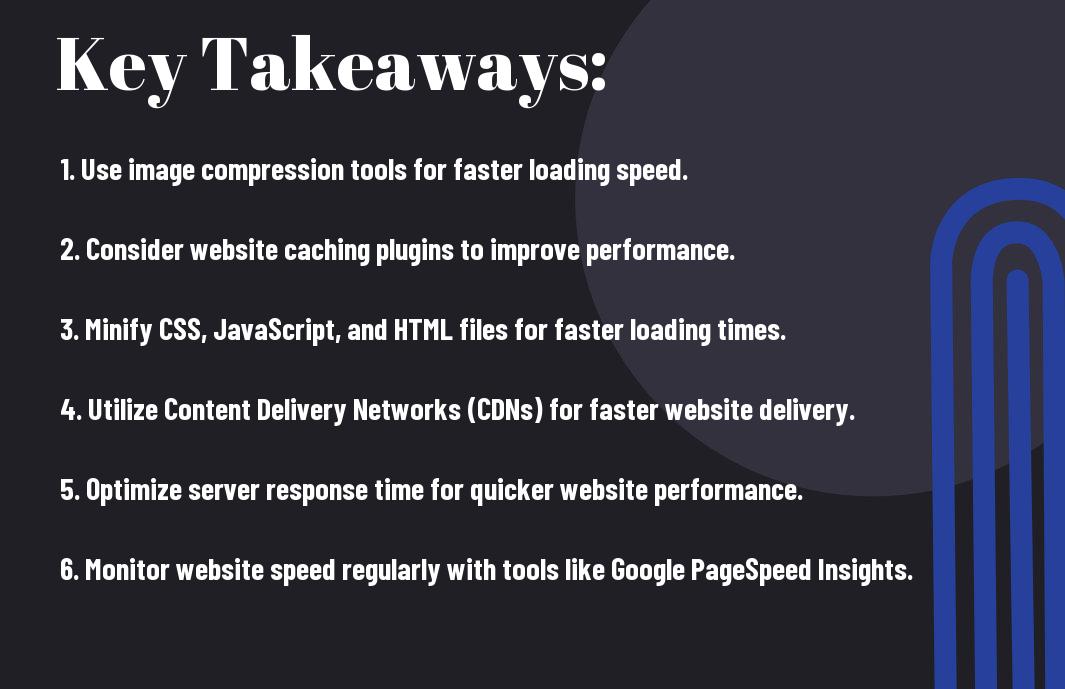What Speed Optimization Tools Are Available For Enhancing Dropshipping Operations?
Most dropshipping businesses rely on fast and efficient operations to stay competitive in the e-commerce market. In order to streamline processes and improve customer experience, utilizing speed optimization tools is essential. These tools can help reduce loading times, optimize performance, and ultimately enhance overall efficiency. For dropshippers looking to boost their productivity and maximize profits, investing in the right tools is crucial. To explore some of the best options available, check out our detailed guide on The Top 17 Dropshipping Software And Tools In 2024.
Key Takeaways:
- Performance Testing Tools: Utilize tools like GTmetrix, Pingdom, and Google PageSpeed Insights to analyze website performance and identify areas for improvement.
- Caching Plugins: Implement caching plugins such as W3 Total Cache or WP Rocket to improve loading times by storing static versions of your site’s content.
- Image Optimization Tools: Use tools like TinyPNG or EWWW Image Optimizer to compress images without compromising quality, reducing file sizes and loading times.
- Content Delivery Networks (CDNs): Integrate CDNs like Cloudflare or Akamai to distribute content across servers worldwide, enhancing speed and reducing server load.
- Lazy Loading Plugins: Install lazy loading plugins such as BJ Lazy Load or A3 Lazy Load to defer offscreen images and videos, improving initial page load times.
Understanding Speed in Dropshipping Operations
The speed of a dropshipping operation refers to how quickly various processes and actions take place within the business. This includes how fast products are sourced, orders are processed, and shipments are delivered to customers. In the world of e-commerce, where competition is fierce and customer expectations are high, speed plays a critical role in the success of a dropshipping business.
Importance of Website Performance
One key aspect of speed in dropshipping operations is the performance of the business’s website. A fast-loading website is essential for providing a seamless shopping experience to customers. Studies have shown that websites that load quickly have higher conversion rates, lower bounce rates, and higher customer satisfaction levels. This means that investing in tools and strategies to optimize website performance can lead to increased sales and customer loyalty.
Furthermore, search engines like Google consider website speed as a ranking factor. A slow website can be penalized in search engine results, leading to lower visibility and fewer organic traffic. Therefore, prioritizing website performance is not only crucial for the customer experience but also for the overall success and visibility of the dropshipping business.
Impact of Speed on Customer Experience
On average, online shoppers expect a website to load in 2 seconds or less. Anything longer than that can result in frustration and abandonment of the site. Slow loading times can lead to a poor customer experience, causing visitors to leave the site without making a purchase. In today’s fast-paced digital world, where instant gratification is the norm, every second counts when it comes to keeping customers engaged and satisfied.
Impact: By prioritizing speed optimization tools and strategies, dropshipping businesses can ensure that their customers have a seamless shopping experience from start to finish. This not only leads to higher conversion rates and increased sales but also fosters customer loyalty and positive word-of-mouth recommendations.

Website Speed Optimization Tools
Assuming you are looking to enhance the speed and efficiency of your dropshipping operations, utilizing the right tools is crucial. Website speed optimization tools are essential for ensuring a seamless user experience and maximizing conversion rates on your e-commerce platform. In this chapter, we will explore some of the top tools that can help you achieve faster loading times and improved performance for your dropshipping website.
Content Delivery Networks (CDNs)
Content Delivery Networks, or CDNs, are a powerful tool for optimizing website speed by reducing server response time and delivering content more efficiently to users. By distributing your website’s static resources such as images, CSS, and JavaScript files across a network of servers worldwide, CDNs help improve loading times for visitors regardless of their geographical location. Popular CDNs like Cloudflare, Akamai, and Amazon CloudFront offer secure and reliable global coverage, ensuring that your website loads quickly for users no matter where they are located.
When integrated properly, CDNs can dramatically reduce latency and improve website performance by caching content closer to the end-users. This results in faster loading times, reduced server load, and enhanced scalability during peak traffic periods. By leveraging a CDN for your dropshipping website, you can provide a seamless browsing experience for customers and boost your SEO rankings by delivering content faster.
Caching Plugins and Services
Content caching is an essential technique for speeding up website performance by storing static resources and dynamically generated content in temporary storage. Caching plugins and services like WP Rocket, W3 Total Cache, and Sucuri help reduce server response times and minimize the need to generate content repeatedly for each visitor. These tools improve loading speeds by serving cached content to users, resulting in a smoother browsing experience and lower bounce rates on your dropshipping website.
With efficient caching plugins and services in place, you can optimize your website for improved performance and faster loading times, ultimately leading to higher conversion rates and increased customer satisfaction. By implementing caching strategies tailored to your specific e-commerce platform, you can significantly enhance the speed and reliability of your dropshipping operations, setting you apart from competitors in the market.
Inventory and Order Processing Tools
Automated Inventory Management Systems
Tools that automate inventory management are essential for dropshipping operations. These systems help ensure accuracy in stock levels and prevent overselling or stockouts. By integrating with your sales channels, automated inventory management tools can update stock levels in real-time, providing a seamless experience for customers.
Additionally, these systems can generate reports on sales trends, best-selling products, and inventory turnover rates. This data can help you make informed decisions about purchasing and marketing strategies, ultimately improving your overall efficiency and profitability.
Efficient Order Processing Software
Order processing software streamlines the fulfillment process by automating tasks such as order verification, printing shipping labels, and updating customers on order status. These tools can help reduce human error and expedite the time it takes to fulfill an order, leading to increased customer satisfaction.
Moreover, order processing software can integrate with multiple sales channels and shipping carriers, allowing you to manage orders from a centralized platform. This centralized approach can save you time and effort by eliminating the need to switch between different systems for each order.
Systems with efficient order processing software often offer features like batch processing, order filtering, and customizable workflow automation. These advanced capabilities can further optimize your dropshipping operations by minimizing manual intervention and maximizing efficiency.
Analytics and Monitoring Tools
Not all speed optimization tools focus solely on improving website performance; some tools also provide valuable insights through analytics and monitoring features. These tools help dropshippers track and analyze various website metrics to identify areas for improvement and enhance overall user experience.
Real-time Performance Dashboards
Performance monitoring tools offer real-time insights into website speed and performance metrics. These dashboards track key indicators such as page load times, server response times, and overall website performance. By monitoring these metrics in real-time, dropshippers can quickly detect any issues that may be affecting their site’s speed and promptly address them to ensure optimal performance.
Real-time performance dashboards also provide historical data and trend analysis, allowing dropshippers to identify patterns and fluctuations in website performance over time. This information is invaluable for making data-driven decisions to continuously optimize website speed and enhance the overall user experience.
Website Speed Testing Services
Testing the speed of a dropshipping website is essential for identifying bottlenecks and areas that need improvement. Website speed testing services, such as GTmetrix and Pingdom, offer comprehensive tools to analyze various aspects of a website’s performance, including page load times, file sizes, and server response times. These tools provide detailed insights into the factors affecting website speed and offer recommendations for optimization.
Tools like GTmetrix and Pingdom also offer performance grades and scores to evaluate the overall speed and performance of a website. By regularly testing website speed and monitoring performance grades, dropshippers can ensure that their site is optimized for speed, leading to improved user satisfaction and potentially higher conversion rates.
Optimization Techniques and Best Practices
Keep your dropshipping operation running smoothly by implementing speed optimization tools and best practices. By utilizing tools such as How to Use Automation to Improve Dropshipping Operations, you can enhance efficiency and customer satisfaction.
Image Compression and File Size Reduction
Compression and reduction of image files can significantly improve the loading speed of your dropshipping website. Image compression tools like TinyPNG or JPEG Optimizer can help reduce the file size without compromising image quality. Additionally, consider using lazy loading techniques to ensure that images are only loaded when they come into view, further reducing load times.
To further optimize your images, make sure to resize images to the correct dimensions before uploading them to your website. This can prevent the browser from having to scale down large images, which can slow down loading times. By implementing these practices, you can create a faster and more user-friendly shopping experience for your customers.
Code Minimization and Script Optimization
Code minimization and script optimization are essential for improving the performance of your dropshipping website. Minifying CSS and JavaScript files can reduce the overall file size, leading to faster loading times. Additionally, consider eliminating any unnecessary code or scripts that may be slowing down your website.
Using a content delivery network (CDN) can also help improve the speed of your website by distributing content across multiple servers worldwide. This can reduce latency and improve load times for customers accessing your website from different locations. By implementing these optimization techniques, you can create a more efficient and enjoyable shopping experience for your customers.
Avoid using too many plugins or scripts on your website, as these can slow down loading times and impact performance. Regularly audit and update your plugins to ensure they are necessary and up to date. By keeping your website clean and optimized, you can provide a seamless shopping experience for your customers while improving your overall dropshipping operations.
Conclusion
Taking this into account, dropshipping businesses can greatly benefit from utilizing speed optimization tools to enhance their operations. By improving website loading times, reducing bounce rates, and boosting overall user experience, these tools can ultimately lead to increased sales and customer satisfaction. It is crucial for dropshippers to stay competitive in the e-commerce landscape by implementing these tools to streamline their operations and stay ahead of the competition.
FAQ
Q: What is speed optimization for dropshipping operations?
A: Speed optimization for dropshipping operations refers to the practice of improving the loading times and overall performance of an online store to provide a better user experience and increase conversions.
Q: Why is speed optimization important for dropshipping businesses?
A: Speed optimization is crucial for dropshipping businesses because faster loading times lead to higher customer satisfaction, lower bounce rates, improved SEO rankings, and ultimately, increased sales.
Q: What speed optimization tools are available for dropshipping operations?
A: There are several tools available for enhancing dropshipping operations, including Google PageSpeed Insights, GTmetrix, Pingdom, WebPageTest, and Shopify’s built-in speed optimization features.
Q: How do these tools help in enhancing dropshipping operations?
A: These tools help in enhancing dropshipping operations by identifying areas for improvement, such as image optimization, CSS and JavaScript minification, caching, and server response times, and providing recommendations to optimize website speed.
Q: Are there any best practices for speed optimization in dropshipping?
A: Yes, some best practices for speed optimization in dropshipping include optimizing images, leveraging browser caching, minimizing HTTP requests, using Content Delivery Networks (CDNs), and regularly monitoring and testing website performance using speed optimization tools.






